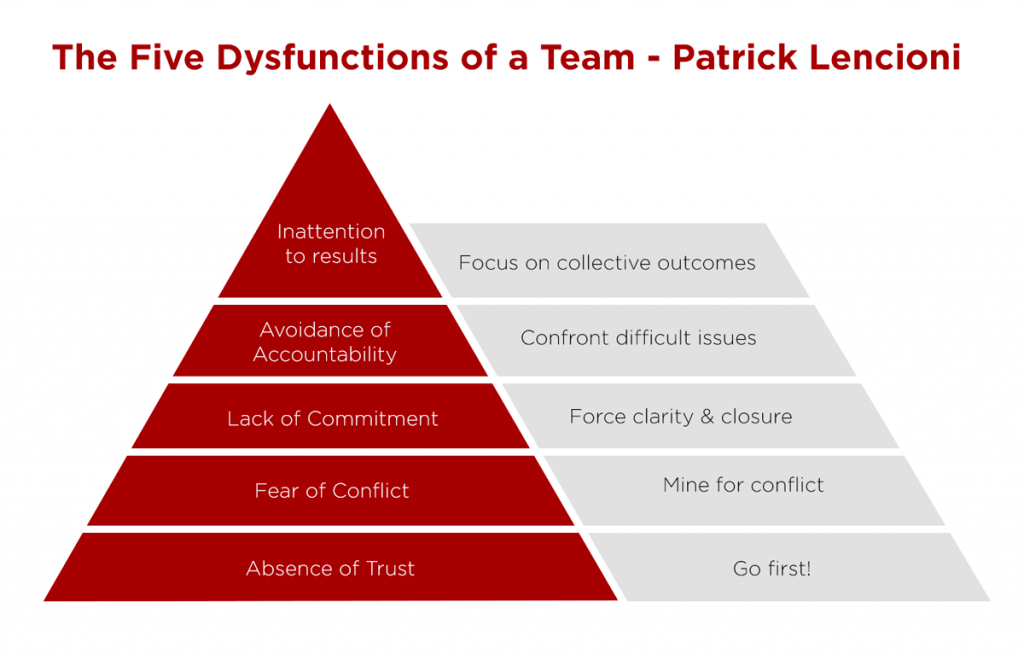A high performance team is your organisation's ultimate secret weapon. Imagine if you could get all the people in your organisation rowing in the same direction - you could dominate any industry, in any market, against any competition, at any time!
Patrick Lencioni is a well-known business management author, who has coached thousands of management teams and CEOs. His 'Five Dysfunctions of a Team' framework is very relevant for understanding how to build a high-performing team. By looking at what makes a dysfunctional team, we can understand how each behaviour leverages off the next and that by doing the opposite, we can build a world-dominating team.
The fear of being vulnerable with team members prevents the building of trust within the team. Vulnerability-based trust is characterised by such things as saying ‘I need help,’ ‘I screwed up' or 'I made an error.’
Solution: Build trust into your team culture by creating an environment of being open and honest, sharing problems, admitting mistakes and assisting each other in a collaborative manner.
The desire to preserve artificial harmony stifles productive, ideological conflict. This creates two problems. Firstly, stifling conflict actually increases the likelihood of destructive, back channel sniping. Secondly, it leads to sub-optimal decision-making because the team is not benefitting from the true ideas and perspectives of its members.
Solution: Welcome productive conflict in your team. Challenge paradigms, encourage others to speak up or out, get input from the team and confront issues quickly. But remember, productive and constructive conflict cannot happen without trust!
The lack of clarity or buy-in prevents team members from making decisions they will stick to. People give up or check out because either artificial harmony on one extreme, or destructive harmony at the other extreme leads to an environment of either fear or fantasy.
Solution: With trust and healthy conflict built into your team culture, engage your team by ensuring you are aligned on common objectives and being clear on direction and priorities.
The need to avoid interpersonal discomfort prevents team members from holding one another accountable for their behaviours and performance. It’s too hard and emotionally draining to be constructively direct with a peer.
Solution: By now, you should have trust, productive conflict and commitment in your team. Accountability is the natural next step. Implementing the same standard for everyone and having clarity over these standards is essential. Team members should be made to feel comfortable to take accountability and to hold each other accountable, even if it is difficult. Likewise, a high performing team also recognises each others' performance with praise or rewards.
The pursuit of individual goals and personal status erodes the focus on collective success. By not focussing on results, you're more likely to see poor performance and higher team turnover.
Solution: With a team now built on trust, healthy conflict, commitment and accountability, the final tip of the pyramid is focussing on results. Results-focussed teams are more highly motivated. Of course, there are a multitude of benefits to having a highly motivated team - one being that you'll be likely to see reduced staff turnover.

So now, if we step back and look at the flip side of each of these five dysfunctions, we can see the characteristics of a High Performance Team:
If you're a leader of a team, commit to addressing the five dysfunctions and see what an enduring difference it makes to your team's culture, performance and motivation.
For more information, ask us about how we can help improve or boost your team culture.

Written by Intepeople Executive Coach, Anna Gibbons.
Coaching is no longer just for under-performers - it’s for the ambitious, those with dreams and goals of thriving to their full potential and being authentic leaders in their organisations.
Here are five great reasons for working with an Executive Coach on your own personal and professional development:
We all know the saying when you’re in a situation, ‘you can’t see the wood for the trees’. When we’re rushing from home to work and juggling being a parent and a partner with our career, we simply do not get the time to sit, self-reflect and create change.
Sure, we can chat with our colleagues, friends and family - but it’s a very different conversation with an executive coach.
The quality of our conversations are crucial and a coach can help keep your clarity and perspective when discussing challenges and stressful situations. Our friends and family are great at offering empathy and sympathy, but a coach tends to hold the space for you to find solutions rather than jump into the pit with you.
The brain likes to offer excuses when you’re trying to get out of doing the things you don’t like doing. But it’s the things we don’t like doing the most that usually have the greatest return or pay off.
An executive coach helps you to ‘lean in’ to these things rather than to ‘lean away’. When you have to meet with your coach to discuss progress and your actions towards your goals, you are no longer able to procrastinate and put things off.
Negative self talk is in everyone’s brain. Yes, EVERYONE'S! The main difference between successful and happy people is that they choose not to listen to it the same as unhappy people or unsuccessful people perhaps do.
The human brain is hardwired to keep us safe so it’s constantly wanting to bring the fear of ‘not being good enough’, or fear of ‘failure’ into our thoughts. However, we no longer have to worry about tigers chasing us, so we need to learn to control this negative self-talk. An executive coach can help you do this by building on your mental tool kit.
Having an executive coach isn’t about finding yourself, it’s about creating yourself.
A coach will ask you questions you may never have been asked before. They will help you picture success and visualise where you want to be, what it feels like, looks like and sounds like. When the brain is in a positive and motivated state, solutions jump out at you and you can more easily make a plan to get where you want to go.
'The definition of insanity is doing the same thing over and over and expecting different results.'
A coach helps you to see the barriers that are holding you back from achieving the results you want. Barriers can be limiting decisions or unhelpful beliefs that no longer serve us. By reconnecting with our values and purpose we are able to work more efficiently and make better decisions.
These are just a few of the many reasons why an executive coach should be part of everyone’s personal and professional development plan. If you are tempted to find out more about Intepeople’s Executive Coaching services, contact us now.
How many times as HR professionals have you been asked to look for a coach or mentor for a learning or performance issue?
You need to ask yourself what are the individual needs of each situation. Sometimes it is coaching that is needed – other times a mentor and often times neither.
Quick recap on the difference between a Coach and a Mentor
A Coach
A Mentor
Here are some tips on how to decide:
Have a look at the performance appraisal of the person - what is the nature of the learning need?
Has the company introduced a new software system or program?
Does the company want to develop employees in specific competencies?
Do you have a few talented individuals who need ongoing leadership advice?
Do you have internal company experience/expertise you wish to retain and pass on to younger staff members?
Do you have staff members who need help with some of the more emotional intelligent areas in their development?
And as I said above sometime you need neither – often looking at other Learning and Development techniques may suit the situation.
Webinars, online learning tools, traditional training courses, exposure to other departments, putting staff on one-off projects are just some of the other methods you can use to fill a training need.
The size of your company and the amount of money you want to spend may also influence your training needs decision.
Another BIG question you need to ask yourself is – Will this training spend actually benefit the company?
I have seen many Business Owners and Managers fork out big sums of money on training that only benefits the individual and is not in the best interest of the company. So spend wisely.
If you have any other tips for helping our community of readers make L&D decisions drop us a note below. We welcome your thoughts and ideas.